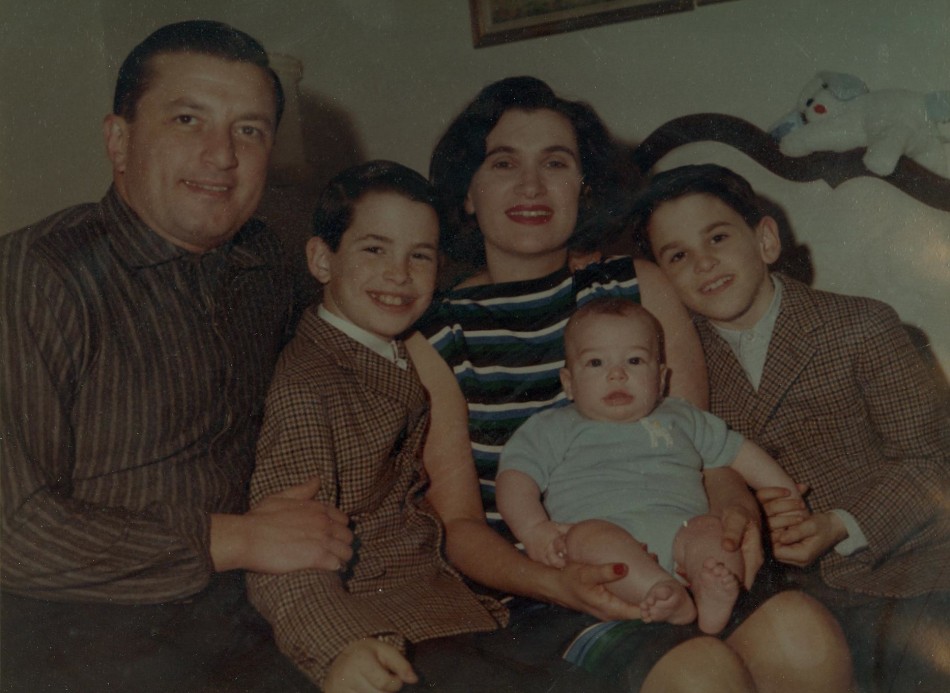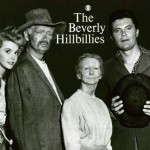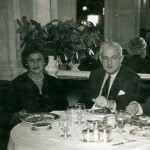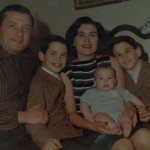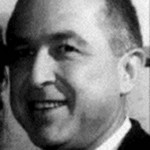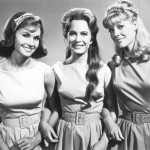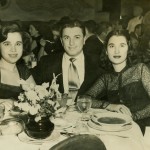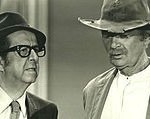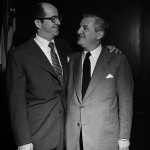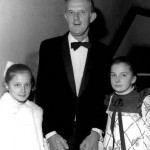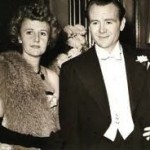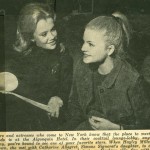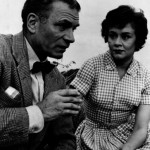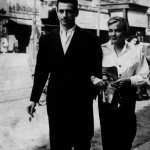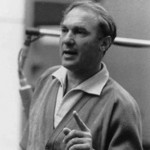by Michael Elihu Colby
Part 6: Could Jed Clampett be Jewish?
In August of 1962, another Algonquin Kid was born, my brother David Bodne Colby. He was the unequivocal hit of the year at our house. In September of 1962, a series was born that was the unequivocal hit of the television season. Created by longtime Algonquin guest, Paul Henning, the TV show was titled The Beverly Hillbillies. The show was about a folksy Southerner who strikes it rich in oil, then moves his family to an incongruously sophisticated setting. My Aunt Norma Mazo, Grandma Mary’s sister, opined this TV family was—at least in part—based on (my grandparents,) the Bodnes.
It may have been pure coincidence, but there were undeniable similarities pointed out by Aunt Norma, aspects that may have influenced Paul Henning during his stays at the Algonquin. Of course, my family—though down-home types—were NOT hillbillies by any means. And it boggles the mind to imagine The Beverly Hillbillies as Jewish. On the other hand, there’s the fact that Grandpa Ben Bodne was an oilman from Tennessee who never made it through school, parallel to the show’s protagonist Jed Clampett (played by Buddy Ebsen). Secondly, the family names on the show were Clampett as well as Bodine—like “Bodne” with an extra “i.” Grandpa Ben’s pet name for his wife was “Granny,” the appellation given the show’s female lead (Irene Ryan). The name of Jed’s daughter, Ellie Mae (Donna Douglas) was similar to Renee (“REE-knee”) Mae, my mother; plus both Ellie Mae and Renee Mae were lovely yet tomboyish. Another parallel was how the show’s simple Southerners took up residence in the most soigné of neighborhoods, surrounded by celebrities. Possibly the pièce de résistance was the episode in which Phil Silvers, as con man Shifty Shafer, tried to sell Jed the Brooklyn Bridge and the Algonquin Hotel.
Paul Henning had previously written for radio (The George Burns and Gracie Allen Show) and for films (Bedtime Story) in addition to TV (Bob Cummings Show, The Andy Griffith Show, The Real McCoys). Some of his shows had rural settings. But The Beverly Hillbillies had the unique premise of country folk suddenly becoming city nabobs. In an interview about the origins of his hit show, Henning declared: “I’d always had a great affection for hillbillies. I think that started when I was a boy scout. I went to camp in the Ozarks… I loved their humor. …I thought if you could take someone from a real hillbilly family and somehow transplant them to a modern city. My first thought was New York. And then I thought this would mean expensive location trips. And why not transplant them to Beverly Hills where you have the same sophistication. And to make that possible they had to suddenly become affluent.” 1
Accordingly, Henning’s influences predated the Bodnes. But it was understandable how Aunt Norma suspected the Algonquin and the Bodnes did provide some food for thought. And then there was Henning’s follow-up show, Petticoat Junction, about a country inn additionally beautified by the owner’s daughters, Betty Jo, Bobbie Jo, and Billie Jo. Henning had actually almost used more than one daughter on The Beverly Hillbillies but waited for this sitcom to feature several. 2
To be honest, there’s less likelihood that Petticoat Junction had any relationship to the Algonquin. Henning knew of the pretty Bodne daughters Renee Mae and Barbara Ann; but it’s implausible that he was influenced by minutiae such as Barbara’s sometimes being called Bobbie. Further, he acknowledged Petticoat Junction was based on an inn run by the grandparents of his wife Ruth: “a little hotel beside the railroad track in a town called Eldon, Missouri and how she and her cousins would go there in the summertime…and how they were always warned by the grandparents not to have anything to do with the traveling salesmen.” 3
My mother and her sister never had to worry about traveling salesmen at the Algonquin. Nonetheless, there’s no doubt that the Algonquin was a favorite spot of Paul and Ruth Henning and alumni of Henning’s shows. Among his stars who stayed there were Buddy Ebsen, Donna Douglas (who became a close family friend), Eva Gabor (of Green Acres); plus Linda Kaye Henning (daughter) and her husband Mike Minor (both actors on Petticoat Junction). All enjoyed a heaping helping of the Bodnes’ Southern hospitality.
The Southern hospitality was equally popular with famous foreign families in the ‘60s. It’s where you’d find the Michael Redgrave family, including film director Tony Richardson (Tom Jones), then married to Vanessa Redgrave and father of future actresses Natasha and Joely. The hotel was likewise where Italian film director Roberto Rosselini, divorced from his third wife Ingrid Bergman, was often visited by their children, Robertino and the twins Isotta and Isabella Rosselini (future star of Blue Velvet). What’s more, it was the favorite NY hotel for the family of Oscar winner John Mills. He stayed there with his writer wife Mary Hayley Bell, son Jonathan, and daughter Hayley. Seen too was his other daughter Juliet (TV’s Nanny and the Professor ). In 1962, while John Mills was making his Broadway debut in Terence Rattigan’s Ross, Mr. and Mrs. Mills gave a delightful interview to Photoplay magazine, talking about their clan. Interviewer Chrys Haranis reported:
“…in his suite at New York’s Algonquin Hotel…I wanted to find out how Mills felt about the career his two daughters had chosen. ‘Mary and I,’ Mills began…’have not tried to push the children into the business. But neither have we sought to discourage them.’ Mrs. Mills interrupted… ‘We have made it a strong point…to ease the way for our children if they wanted to go into show business. So we gave the children names that would look good on a marquee.’ “ 4
Indeed, Mrs. Mills wrote the successful film version of her book, Whistle Down the Wind, to star Hayley. Even their son Jonathan considered becoming an actor while staying at the hotel:
“…on vacation, he came to the States and saw me in Ross every night. … He would storm around the hotel quoting great portions of the play. I think his day in show business isn’t far off.” 5
Then there was Laurence Olivier. Through several wives and accompanied by various family members, Olivier was perhaps the longest-running British idol at the Algonquin. In the early 1960s, while Olivier appeared on Broadway in Beckett, he romanced and married his third wife Joan Plowright, also at the hotel during her Tony-winning run in A Taste of Honey; they later returned with their three children. As for Olivier, according to his biographer Francis Beckett, since 1930 when Olivier first became a star and visited New York, “he started a regular love affair with the Algonquin Hotel, which persisted all his life.” 6 His attachment to the Algonquin was so profound, his second wife Vivien Leigh made a special (bittersweet) trip there. Though divorced, she was still in love with him and asked to visit the room where he customarily stayed. Even without him present, it was enough for this exceptional actress to retrace where he so often resided.
Through the years, Olivier became very fond of my grandparents and vice verse. When Olivier was sick with a bad cold, Grandma Mary cooked her Jewish penicillin—i.e. homemade chicken soup—for him. And who could blame him for being grateful? Grandma made the best Southern chicken soup (and matzo balls) I ever tasted.
Closest of all to my Grandmother was Simone Signoret, who stayed at the Algonquin with her singer/actor husband Yves Montand and daughter Catherine Allegret. Signoret was one of France’s all-time great actresses. Her French film classics included La Ronde and Les Diaboliques. In Hollywood, she won Best Actress for Room at the Top, to put next to her César, three BAFTAs, and Emmy Award. As for Montand, he was among the most debonair entertainers ever seen at the Algonquin, even counting Gregory Peck, Tyrone Power, Charles Boyer, and Douglas Fairbanks Jr. Signoret and Montand discovered the Algonquin via their friend Norman Granz, the legendary jazz producer and Algonquin regular who launched An Evening with Yves Montand, Montand’s smash 1959 Broadway (and American) debut. Like Laurence Olivier, Signoret and Montand fell in love with the hotel on first visit, staying there during the show’s run. In Signoret’s biography, Nostalgia Isn’t What It Used To Be, the actress wrote:
“A few snobbish Americans had laughed at us when we had announced before leaving Paris that we were going to stay at the Algonquin in New York. The Algonquin! That was the place to go twenty or thirty years ago, when Mr. So-and-so and Mrs. So-and-so and Miss So-and-so lived there, wrote their music, their plays, or their terrible reviews which demolished everyone else’s plays… Since we’d never heard of any of those So-and-sos, we’d let them talk, and instead of going to one of those big palaces they suggested, we followed the advice of Uncle Norman; out-of-date provincials that we were, we were going to stay at the Algonquin.
The Algonquin is like La Colombe. It belongs to a family, the Bodnes. If we had lived at the Waldorf-Astoria, I doubt very much whether we would ever have met Mr. Waldorf or Miss Astoria. At the Algonquin, the Bodne family awaited us in the lobby.
The lobby reminded me of the smoking room of the Savoy, with its mahogany and overstuffed armchairs; it reminded me of the lobby of the Alkron, with all its traffic; and it reminded me of a Viennese teahouse, with the quiet good manners of all that bustles.
Mrs. Bodne said she was sure that Catherine [Simone’s daughter from an earlier marriage] would join us very soon. That one sentence said it all. Welcome. I don’t know you but I do. Your show is going to be a success, you’ll see; I know you’re only going to bring over your daughter if it works. This is my way of saying good luck.
Norman, the Californian who only likes New York for its jazz musicians and his stays at the Algonquin, where the switchboard girls serve as his secretaries and the Bodnes as his true family—Norman had told them all about us.” 7
Through the years, my Grandmother and Signoret grew even closer. Grandma babysat when Simone’s young daughter, Catherine Allegret visited her mother. She was Signoret’s confidante during difficult periods, as when Montand engaged in a brief but highly publicized affair with Marilyn Monroe (during the making, ironically, of the film Let’s Make Love). In fact, Signoret once called Grandma one of her truest friends in the world. Many felt similar affection. Grandma was someone who made New York feel like home to notables from far and near.
My grandmother was anything but perfect. As I’ll describe in other chapters, she could be meddling, bossy, illogical, and display such habits as picking from everyone’s plate while they were still eating. But, to those she loved, she was most generous of souls. She was truly the matriarch of the Algonquin—as to her own large family of sisters, brothers, and others—with a hospitality that transcended just Southern comfort.
Next part: A Mazel Tov from Robert F. Kennedy
1 Paul Henning Interview: EMMYTVLEGENDS.ORG. Interviewed by Bob Claster, Toluca Lake, CA 1997. Archive of American Television: http://www.emmytvlegends.org/interviews/people/paul-henning#
2 Paul Henning Interview. Ibid.
3 Paul Henning Interview. Ibid.
4 Haranis, Chrys. “BLIMEY! THE WHOLE BLOOMIN’ BUNCH HAS BEEN BITTEN BY THE BLOOD BUG!” in Photoplay magazine. New York: Macfadden Publications, August 1962.
5 Haranis, Chrys. Ibid.
6 Beckett, Francis. Laurence Olivier. London, Great Britain: Haus Publishing Limited, 2005.
7 Signoret, Simone. Nostalgia Isn’t What It Used to Be (English translation). New York: Harper & Row, 1978.
***Visit The Museum of the City of New York online : http://collections.mcny.org/
*No copyright Infringement Intended. For Entertainment Purposes Only.
Click Below for Parts 1 thru 5:
https://www.theaterpizzazz.com/algonquin-kid-part-way-back/
https://www.theaterpizzazz.com/algonquin-kid-part-2-algonquin-renaissance/
https://www.theaterpizzazz.com/algonquin-kid-part-3-series/
https://www.theaterpizzazz.com/algonquin-kid-part-4-series/
https://www.theaterpizzazz.com/algonquin-kid-part-5-series/


